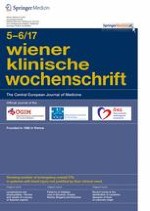Erschienen in:

26.01.2017 | original article
Primary surgical repair of acute Achilles tendon rupture: comparative results of three surgical techniques
verfasst von:
Dragan Lonzarić, Aleksandar Kruščić, Dejan Dinevski, Petra Povalej Bržan, Breda Jesenšek Papež
Erschienen in:
Wiener klinische Wochenschrift
|
Ausgabe 5-6/2017
Einloggen, um Zugang zu erhalten
Summary
Purpose
To determine which of the three surgical techniques for acute unilateral complete rupture of Achilles tendons in use at the University Clinical Centre Maribor gives the best short-term functional results.
Methods
In the retrospective analysis of the results of 3 surgical techniques, 262 patients of which 244 (93.1%) were men (mean age 41.6 ± 10.0 years, range 21.5—83.0 years) operated on during the period from 2000 to 2008 were included. Group A (open technique with fascial augmentation) included 42 (16%) patients, group B (original modification of percutaneous suturing according to Čretnik and Kosanović) included 159 (60.7%) patients, and group C (original percutaneous fixation with two embracing and crossed loops according to Kruščić) included 61 (23.3%) patients. The rehabilitation protocol for group C included use of individually manufactured closed ankle functional orthosis, which replaced the plaster cast after 2 weeks of immobilization and permits early ankle range-of-motion exercising and full weight bearing. The functional outcome and incidence of postsurgical complications were analysed from medical records covering the period of 6 months.
Results
Patients from group C achieved the best functional results in the shortest time. The duration of immobilization (5.3 ± 0.1 weeks) and use of crutches (5.3 ± 0.5 weeks) were the shortest. The ability to rise up on toes on the affected leg, to walk on toes and heels, and duration of restriction of physical activities including sports were shorter than in the other two groups (p < 0.001 for all variables). Two reruptures were experienced in group B, one in group C, and none in group A.
Conclusions
Good functional results and a relatively small number of postsurgical complications advocate the use of percutaneous suturing techniques. The best and fastest functional recovery was attained in the group treated with the original technique of percutaneous fixation with two embracing and crossed thread loops according to Kruščić.